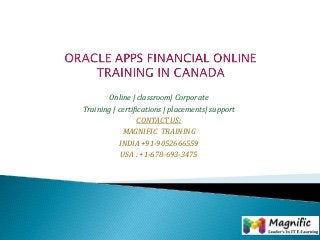
Oracle apps financial online training in canada
- 1. Online | classroom| Corporate Training | certifications | placements| support CONTACT US: MAGNIFIC TRAINING INDIA +91-9052666559 USA : +1-678-693-3475
- 2. Introduction List the Oracle Database 10g Main Features An Overview of: components, internet platform, apps server and developer suite Describe Relational and Object Relational Database Designs Review the System Development Life Cycle Define the term Data Models Describe different means of Sorting Data Show how Multiple Tables can be related Describe how SQL Communicates to the Database
- 3. Define projection, selection, and join terminology Review the basic SQL SELECT statement syntax Select all columns using a wildcard notation from a table State simple rules and guidelines for writing SQL statements Write a query containing the arithmetic operators Create a character expression with the concatenation operator Using the iSQL*Plus Environment SQL statements versus iSQL*Plus commands
- 4. Limit rows using a selection Using the WHERE clause to retrieve specific rows Using the comparison conditions in the WHERE clause Use the LIKE condition to compare literal values List the logical conditions AND, OR, NOT Describe the rules of precedence for the conditions Sort rows with the ORDER BY clause Use ampersand substitution in iSQL*Plus to restrict and sort output at run time
- 5. Show the differences between single row and multiple row SQL functions Categorize the character functions into case manipulation and character manipulation types Use the character manipulation functions in the SELECT and WHERE clauses Explain and use the DATE and numeric functions Use the SYSDATE function to retrieve the current date in the default format Introduce the DUAL table as a means to view function results List the rules for applying the arithmetic operators on dates Use the arithmetic operators with dates in the SELECT clause
- 6. Describe and categorize the group functions Use the group functions Utilize the DISTINCT keyword with the group functions Describe how nulls are handled with the group functions Create groups of data with the GROUP BY clause Group data by more than one column Avoid illegal queries with the group functions Exclude groups of data with the HAVING clause
- 7. Identify Types of Joins Retrieve Records with Natural Joins Use Table Aliases to write shorter code and explicitly identify columns from multiple tables Create a Join with the USING clause to identify specific columns between tables Use the ON clause to specify arbitrary conditions or specify columns to Join Create a Three-way join with the ON clause to retrieve information from 3 tables List the Types of Outer Joins LEFT, RIGHT, and FULL Generating a Cartesian Product
- 8. List the syntax for sub queries in a SELECT statements WHERE clause List the guidelines for using sub queries Describe the types of sub queries Execute single row sub queries and use the group functions in a sub query Identify illegal statements with sub queries Execute multiple row sub queries Analyze how the ANY and ALL operators work in multiple row sub queries
- 9. Use the UNION operator to return all rows from multiple tables and eliminate any duplicate rows Use the UNION ALL operator to return all rows from multiple tables Describe the INTERSECT operator Use the INTERSECT operator Explain the MINUS operator Use the MINUS operator List the SET operator guidelines Order results when using the UNION operator
- 10. Write INSERT statements to add rows to a table Copy rows from another table Create UPDATE statements to change data in a table Generate DELETE statements to remove rows from a table Use a script to manipulate data Save and discard changes to a table through transaction processing Show how read consistency works Describe the TRUNCATE statement
- 11. List the main database objects and describe the naming rules for database objects Introduce the schema concept Display the basic syntax for creating a table and show the DEFAULT option Explain the different types of constraints Show resulting exceptions when constraints are violated with DML statements Create a table with a sub query Describe the ALTER TABLE functionality Remove a table with the DROP statement and Rename a table
- 12. Categorize simple and complex views and compare them Create a view Retrieve data from a view Explain a read-only view List the rules for performing DML on complex views Create a sequence List the basic rules for when to create and not create an index Create a synonym
- 13. Describe the structure of each of the dictionary views List the purpose of each of the dictionary views Write queries that retrieve information from the dictionary views on the schema objects Use the COMMENT command to document objects
- 14. Controlling User Access System versus Objects Privileges Using Roles to define user groups Changing Your Password Granting Object Privileges Confirming Privileges Granted Revoking Object Privileges Using Database Links
- 15. Using the ALTER TABLE statement Adding a Column Modifying a Column Dropping a Column, Set Column UNUSED Adding, Enabling and Disabling Constraints Creating Function-Based Indexes Performing FLASHBACK operations External Tables
- 17. http://www.oracleappsfinancialsonlinetrainings.net -oracle apps financial Online Training contact us: info@magnifictraining.com or +919052666559 By Real Time Experts from Hyderabad, Bangalore,India,USA,Canada,UK, Australia,South Africa.